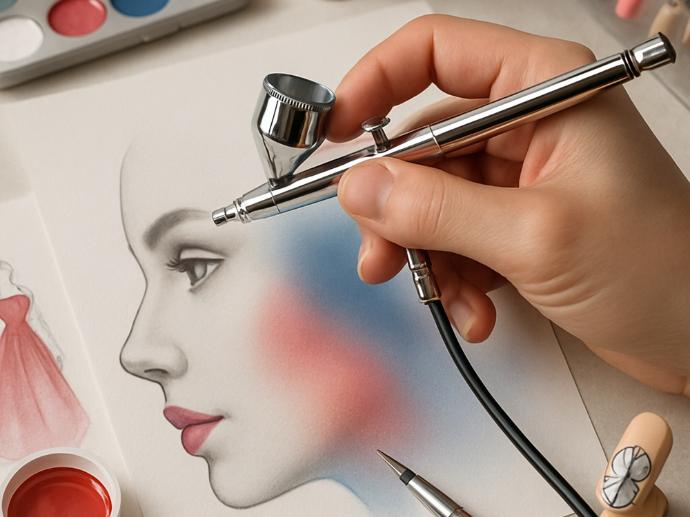In
fields like art creation, model making, makeup, and nail art, the airbrush is
an irreplaceable precision tool. Compared to hand brushes and traditional spray
equipment, airbrushes can achieve ultra-fine lines, smooth gradients, and
delicate color transitions, elevating creative expression to the next level.

How
Airbrushes Work
An airbrush uses compressed air to atomize thinned paint and spray it delicately onto the surface. Based on operation type, airbrushes are mainly divided into single-action and double-action types: single-action airbrushes control only airflow, with paint volume preset; double-action airbrushes control both airflow and paint volume simultaneously, offering more flexible adjustment of line thickness and spray intensity.
Additionally,
airbrushes come in gravity feed, siphon feed, and side feed designs. Gravity
feed suits detailed work, siphon feed handles large-area spraying, and side
feed balances both.
How
to Choose the Right Airbrush
Consider these factors:
- Needle Size: Fine needles (e.g., 0.2mm) are ideal for ultra-detailed work like skin textures and hair strands; medium sizes (e.g., 0.3mm) are for general coatings; large needles (e.g., 0.5mm or above) suit background and large-area spraying.
- Compressor
Compatibility: A
high-quality compressor should provide stable air pressure, low noise, and
proper air filtration to prevent moisture or oil contamination.
- Double vs. Single Action: Beginners can start with single-action, but professional creators are recommended to use double-action for greater creative freedom.
- Brand
and Durability:
Well-known brands (like Iwata, Harder & Steenbeck, Badger) ensure
durability and reliable access to replacement parts.
Practical
Tips
- Paint Thinning: Airbrushes require high paint fluidity; use dedicated thinners to achieve a milk-like consistency.
- Air Pressure Adjustment: Typically set between 15–30 psi. Too low leads to clogs; too high causes splattering.
- Spray Distance and Angle: Keep 5–10 cm for fine detail work; extend to 15–20 cm for background spraying.
- Layering and Gradient: Thin, multiple layers create delicate depth and prevent paint buildup or runs better than a single thick coat.
- Masking
Techniques:
Use masking tape, masking fluid, or stencils to create sharp edges and special
patterns.
Daily
Maintenance
A
precision airbrush requires careful care. After each use, immediately flush the
needle and paint cup with cleaner to prevent dried paint clogs. Regularly
disassemble for deep cleaning, checking O-rings, needles, and nozzles for wear.
Store upright or in a dedicated holder to avoid nozzle damage.
Creative
Application Examples
- Illustration Art: Airbrushes create smooth gradients and lighting effects, widely used in realistic and fantasy art.
- Model Making: Whether Gundam, military models, or car kits, airbrushes are essential for detailed paintwork and weathering effects.
- Makeup and Body Art: Professional makeup artists use airbrushes for stage makeup, special effects, and flawless airbrush cosmetics.
- Nail
Art:
Nail artists use airbrushes to design gradients, patterns, and unique textures
on nails.
Future
Trends and Innovations
With advancements in material science and digital manufacturing, the airbrush world is seeing several innovations:
- Wireless Airbrushes: Equipped with mini rechargeable compressors, freeing up workspace.
- Smart Control Systems: High-end airbrushes feature digital displays for precise air and flow adjustments.
- Eco-Friendly
Paints:
The spread of low-VOC, non-toxic paints makes creation safer and more
environmentally friendly.
Final
Thoughts
An
airbrush is a magical tool that transforms a creator's inspiration into
delicate visual language. From tool selection and technique practice to
maintenance, every step influences the final artwork's quality and expression.
Only continuous learning and experimentation will help you go further on your
artistic journey. We hope this article serves as your guide to exploring the
world of airbrushes, helping you create ever more stunning works.